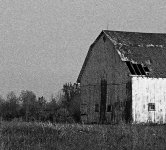sbug
Acceptably Sharp
Well, I've finally developed a couple of rolls of Tri-X in Rodinal after exclusively using Diafine for 7+ months. I LOVE Diafine but I don't need the speed bump when it's bright and sunny out and I've heard plenty of good things about Rodinal. Anyhow, my first try was a poorly managed stand development. So, my second roll was strictly by the box. 1:50, 12 minutes, constant agitation for the first minute, 5 seconds of every 30 seconds thereafter. I agitated fairly gently. What I got back is much more grainy than expected. Plus I got the funny light edges at the top and bottom of several frames where the film is in contact with the spool. I have not had these issues w/Diafine.
What am I doing wrong? Gentler agitation? Inversions rather than agitation? Shorter developing times? Longer? I want to like this stuff but so far I'm not getting the results I am hoping for.
The attached shot is aesthetically boring as drying paint but it shows the light top and bottom edges and the grain. The grain is much more noticeable of course when I don't compress the shot for the web so I have attached a crop that is not resized from the original scan.
What am I doing wrong? Gentler agitation? Inversions rather than agitation? Shorter developing times? Longer? I want to like this stuff but so far I'm not getting the results I am hoping for.
The attached shot is aesthetically boring as drying paint but it shows the light top and bottom edges and the grain. The grain is much more noticeable of course when I don't compress the shot for the web so I have attached a crop that is not resized from the original scan.



